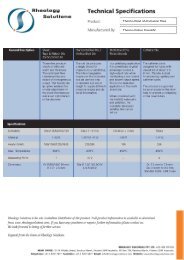Download - Rheology Solutions
Download - Rheology Solutions
Download - Rheology Solutions
Create successful ePaper yourself
Turn your PDF publications into a flip-book with our unique Google optimized e-Paper software.
application notes & technical articles<br />
What Happens When Rheological<br />
Properties Change?<br />
Looking into rheological properties with simultaneous<br />
collection of microscopic images<br />
To gain information about the<br />
reasons for certain changes in<br />
rheological properties, a new<br />
special module for the HAAKE<br />
MARS has been developed.<br />
biennial 07-08<br />
polymer industries<br />
food industries<br />
pharmaceutical, cosmetic<br />
& allied industries<br />
chemical & allied industries<br />
surface coatings industries<br />
It combines a temperature control unit for<br />
cone/plate- and plate/plategeometries<br />
with a state-of the- art microscope. The<br />
RheoScope module is presented and example<br />
data from different applications is shown.<br />
<strong>Rheology</strong> is a”macroscopic“method, which tells<br />
us how a material behaves under given conditions<br />
but never tells us why. For an understanding<br />
about the reasons why a certain behaviour<br />
occurs, we need to combine rheology with a<br />
“microscopic method“ able to look into the<br />
structure of the material.<br />
Examples for such techniques complementing<br />
rheological measurements are GPC, thermal<br />
analysis, (FT)IR or microscopy. Running two<br />
independent measurements on different<br />
instruments, however, doubles instrument time<br />
application notes & technical articles<br />
Rheological Characterisation<br />
of Asphalt Binders<br />
construction &<br />
building industries<br />
The bitumen binders used in<br />
asphalt are playing a crucial<br />
role for the performance of the<br />
asphalt.<br />
Today, 25% of the binders are polymer modified<br />
bitumen (PmB), providing a more sophisticated<br />
performance and a wider temperature range than<br />
pure bitumen does. The future share of PmB is<br />
likely to grow due to environmental regulations,<br />
due to a higher quote of recycling asphalt and<br />
due to requests for lower temperature processing<br />
e.g. for air port run ways.<br />
A first world-wide applied standard for asphalt<br />
binders was determined in the US Strategic<br />
Highway Research Program (SHRP) which was<br />
started in 1987. The results were published in<br />
1993, standardizing for rheological testing a<br />
Dynamic Shear Rheometer (DSR) to investigate<br />
and predict the fatigue behaviour (4°C and 40°C)<br />
and the behaviour at elevated temperatures<br />
(46°C and 82°C) with a steady state stepped<br />
temperature profile with steps of 6 degrees –<br />
corresponding to the performance grades.<br />
Moreover, the processability of the binders is<br />
tested at 135°C with a rotational viscometer or<br />
rheometer.<br />
In order to achieve the standard compliant<br />
temperature accuracy of ± 0.1 deg<br />
or better, particular SHRP temperature control<br />
and measuring time and often leaves a bit of a<br />
doubt whether the sample and its treatment<br />
before measuring have been exactly the same.<br />
The double effort of time and resources can be<br />
avoided by running two different methods on the<br />
same sample simultaneously, testing its<br />
macroscopic and its microscopic properties. The<br />
two resulting data sets can easily be correlated<br />
since they have been collected at the same time<br />
on the same sample.<br />
A complete copy of this application note is<br />
available by requesting V-228<br />
units were designed in the 1990s (Fig.2). Today,<br />
more and more measurements are made with<br />
Peltier temperature control units, e.g. for the<br />
screening of differently modified PmBs. The<br />
Peltier temperature control units provide a wider<br />
temperature range – also facilitating the relevant<br />
sub ambient temperatures.<br />
When bitumen or PmB is subjected to cooling, it<br />
shows exceptionally strong shrinkage leading to<br />
higher forces than the already high forces that<br />
are brought about by shrinking thermoplastics.<br />
The shrinkage of asphalt binders may lead to<br />
quality issues and it is therefore of interest to<br />
determine the occurring normal force and the<br />
shrinkage in micrometers.<br />
A complete copy of this application note is<br />
available by requesting V-225<br />
16 www.rheologysolutions.com










